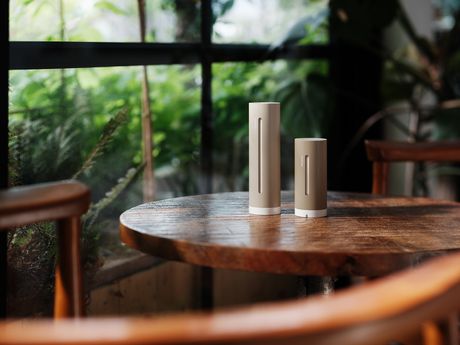
Netatmo präsentiert die Wetter Station ORIGINAL

Bis zu -50 % auf eine Auswahl an ProduktenKaufen

Eine Wetterstation wird auch als Wetterwarte oder Wetterhütte bezeichnet. Es ist ein Messgerät, das aus verschiedenen Sensoren besteht und unterschiedliche Funktionen erfüllt.
Es gibt riesige, hochentwickelte Systeme, die zum Beispiel vom Deutschen Wetterdienst genutzt werden, aber auch solche, die für die breite Öffentlichkeit bestimmt sind. Eine Wetterstation kann als Thermometer, Uhr, Geräuschpegelmesser, Luftfeuchtigkeitsmesser, Windmesser, Barometer, Regenmesser, usw. dienen. Sie kann auch Informationen über die Luftqualität, die Mondphasen oder die Schadstoffbelastung in den Innenräumen liefern.
Wetterstationen in Privathaushalten haben sich in den letzten Jahren immer häufiger durchgesetzt. Sie sind zu einem Modeobjekt geworden (insbesondere vernetzte Wetterstationen, das Aushängeschild des IoT und der vernetzten Dinge).
Gärtner, Landwirte, Segler, Seefahrer, Wanderer, Mountainbiker, Zimmerleute, Arbeiter, usw. Jeder, der genaue Wetterinformationen benötigt, für den kann die Nutzung einer Wetterstation nützlich sein.
Aber das ist noch nicht alles: Viele Wetterstationen liefern auch Daten über die Luftatmosphäre im Haus, wie Luftqualität, Luftfeuchtigkeit und Lufttemperatur.
Warum sollte man also eine Wetterstation zu Hause nutzen? Es ist damit einfach, das Wetter besser vorherzusagen als der Wetterdienst und die Qualität der Luftatmosphäre zu Hause zu analysieren. Dies ermöglicht es, die Innenumgebung des Hauses zu kontrollieren, aber auch die Außenumgebung und klimatische Gefahren besser vorauszusehen.
Kommen wir nun zu den Funktionen einer Wetterstation im Detail.
Mit allen Informationen über die Qualität des lokalen Außenklimas und der Innenraumluft auf dem Bildschirm Ihrer mobilen Geräte ist alles einfacher. Die intelligente Wetterstation von Netatmo hilft Ihnen, Dinge wie die Umweltverschmutzung und unerwartete Wetterereignisse zu messen, vorherzusagen und entsprechend darauf zu reagieren. Informiert zu sein ist der beste Weg, um sich zu schützen. Die die intelligente Wetterstation von Netatmo ist hier Ihr Verbündeter!
Wind, Luftdruck, Temperatur, Luftfeuchtigkeit, Wettervorhersagen, Lufqualität, usw. - was misst eine Wetterstation eigentlich?
Die Variablen, die eine Wetterstation misst, hängen vom jeweiligen Gerät ab. Vor allem lassen sie sich in zwei große Kategorien einteilen: Variablen der äußeren Umgebung (zum Beispiel das Wetter) und Variablen der inneren Umgebung (beispielsweise die Luftqualität).
Beginnen wir mit den externen Variablen:
Kommen wir nun zu den Variablen innerhalb des Hauses:
Die Kombination dieser Daten gibt Ihnen die Möglichkeit, durch deren Regulierung auf sie einzuwirken. Der Einsatz einer Wetterstation zur Durchführung dieser Messungen ist ein erster Schritt, aber die eigentliche Frage ist, was Sie damit machen werden.
Wie bereits erwähnt, gibt es nicht nur eine Art von Wetterstation. Es gibt viele von ihnen!
Die intelligente Wetterstation von Netatmo ist mehr als nur eine gewöhnliche Wetterstation. Das vernetzte System bietet eine breite Palette von Messungen und liefert Ihnen alle Daten über den Innen- und Außenbereich Ihres Hauses direkt auf den Bildschirm Ihres Smartphones! Stellen Sie sich auf die Wetterbedingungen ein und sorgen Sie gleichzeitig für eine hervorragende Luftqualität in Innenräumen.
Ob verkabelt oder drahtlos, verbunden oder nicht, mit oder ohne Display, mit der einen oder anderen Funktion - es gibt kein einheitliches Modell einer Wetterstation.
Beachten Sie, dass es sich hier um private (oder gewerbliche, aber im Handel erhältliche) Wetterstationen handelt und nicht um professionelle Modelle.
Um die ideale Wetterstation auszuwählen, müssen Sie zunächst den Verwendungszweck der Station festlegen. Wozu brauchen Sie eine Wetterstation? Um Ihre Luftqualität zu Hause zu verbessern? Zum Navigieren? Für das Gärtnern? Zum Anbauen von Pflanzen? Für zuverlässige Wetterinformationen? Alles auf einmal?
Je mehr man vom Wetter abhängig ist, desto wichtiger ist es, dass man es genau vorhersagen kann. Je empfindlicher die Menschen in Ihrer Wohnung auf Luftverschmutzung reagieren, desto wichtiger ist es, für eine gute Raumluftqualität zu sorgen. Welche Wetterstation ist also die richtige für Sie?
Es gibt 2 Haupttypen von Wetterstationen: die klassische Wetterstation mit Sensoren und die vernetzte oder intelligente Wetterstation.
Dies ist das Einstiegsmodell der Wetterstation. Sie ist effizient, aber begrenzt und verwendet Sensoren, um die gesammelten Daten auf einem Bildschirm anzuzeigen. Trotz eines sehr günstigen Preises bleibt die Anzeige in Echtzeit.
Die vernetzte Wetterstation ist das am weitesten entwickelte Gerät. Sie verwendet auch Technik, um die auf ihrem Bildschirm angezeigten Echtzeitdaten aufzeichnen und überträgt diese Informationen zusätzlich an Ihr Smartphone oder Tablet. Über das WLAN liefert die angeschlossene Wetterstation auch Daten direkt vom Deutschen Wetterdienstes.
Sie ist ein vollständigeres, präziseres und praktischeres Gerät, aber natürlich auch teurer. Für eine effektive Datenmessung innerhalb und außerhalb des Hauses ist dies jedoch immer noch die beste Lösung.
Sie wissen jetzt alles über die Wetterstation: was sie ist, ihre Funktionen und ihre verschiedenen Varianten. Sie müssen nur wissen, welche Art von Gerät sie suchen (klassisch oder vernetzt), die Angebote vergleichen und das Produkt auswählen, das Ihren Anforderungen entspricht!